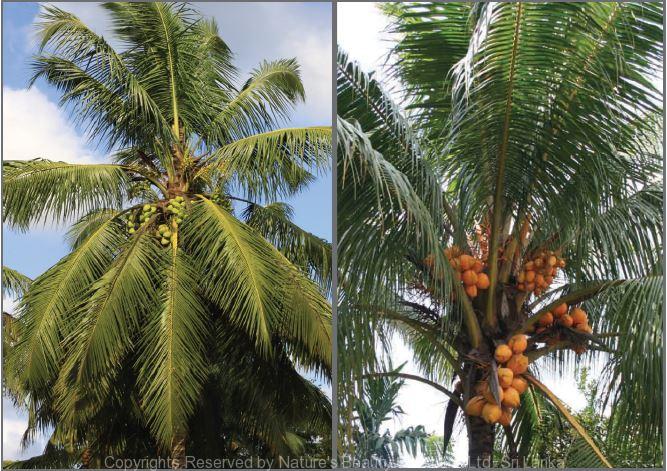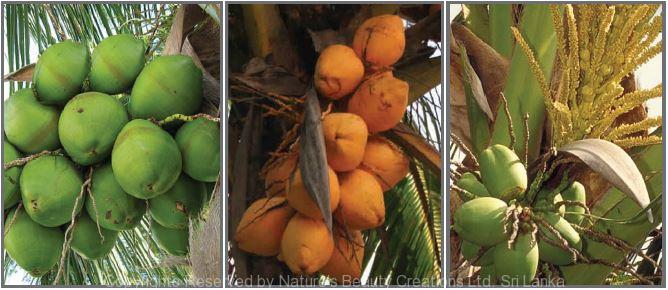

Traditional Knowledge
Useful plant parts :
Fruit, flower and root
Uses in traditional medicine :
- Young fruit pulp is a treatment for sun-stroke
- Coconut water acts as a diuretic and as an anthelmintic
- Flower juice is used in dysentery
- Kernel oil promotes hair growth
- Root sap acts as an astringent and is used for dysentery and for strengthening of gums
Scientific Research
Chemical constituents:
Phenolic compounds: 4-hydroxybenzoic acid, ferulic acid, 4-coumaric acid, 4-hydroxybenzaldehyde and vanillic acid from husk and leaves; Catechins, epicatechins and condensed tannins and B-type procyanidins from water extract of husk; amino acids: alanine, β-alanine, arginine, asparagine, glutamine and aspartic acid from nut water; terpenes: lupeol and skimmiwallin derivatives from epicuticular wax of leaves
Bioactivity :
Husk fibre extract: free radical scavenger, antimicrobial, inhibitor of acyclovir-resistant HSV 1, wound healing, antileishmanial; crude extract of husk: cytotoxic, antinociceptive, anti-inflammatory; nut water: antioxidative; alcohol extract of shell: antifungal; ethanol extract of endocarp: vasorelaxant, antihypertensive; virgin coconut oil: antithrombotic effect
Clinical:
Note :
An important ingredient of Sri Lankan culinary
References : Alviano, D. S. et al., (2004), Antinociceptive and free radical scavenging activities of Cocos nucifera L. (Palmae) husk fiber aqueous extract, Journal of Ethnopharmacology, 92(2-3), 269-27. Bankar, G. R. et al., (2011), Vasorelaxant and antihypertensive effect of Cocos nucifera Linn. endocarp on isolated rat thoracic aorta and DOCA salt-induced hypertensive rats, Journal of Ethnopharmacology, 134(1), 50-54. Dey, G. et al., (2005), Profiling C6–C3 and C6–C1 phenolic metabolites in Cocos nucifera, Journal of Plant Physiology, 162(4), 375-381. Erosa, F. F. et al., (2002), Major Components from the Epicuticular Wax of Cocos nucifera, Journal of the Mexican Chemical Society, 46(3), 247-250. Esquenazi, D. et al., (2002), Antimicrobial and antiviral activities of polyphenolics from Cocos nucifera Linn. (Palmae) husk fiber extract, Research in Microbiology, 153(10), 647-652. Fonseca, A. M. D. et al., (2009), Constituents and antioxidant activity of two varieties of coconut water (Cocos nucifera L.), Brazilian Journal of Pharmacognosy, 19(1B), 193-198. Koschek, P. R. et al., (2007), The husk fiber of Cocos nucifera L. (Palmae) is a source of anti-neoplastic activity, Brazilian Journal of Medical and Biological Research, 40, 1339-1343. Mendonça-Filho, R. R. et al., (2004), Leishmanicidal activity of polyphenolic-rich extract from husk fiber of Cocos nucifera Linn. (Palmae), Research in Microbiology, 155, 136-143. Nevin, K.G. and Rajamoha, T., (2008), Influence of virgin coconut oil on blood coagulation factors, lipid levels and LDL oxidation in cholesterol fed Sprague–Dawley rats, European e-Journal of Clinical Nutrition and Metabolism, 3(1), 1-8. Rinaldi, S. et al., (2009), Characterization of the antinociceptive and anti-inflammatory activities from Cocos nucifera L. (Palmae), Journal of Ethnopharmacology, 122(3), 541-546. Srivastava, P. and Durgaprasad, S., (2008), Burn wound healing property of Cocos nucifera: An appraisal, Indian Journal of Pharmacology, 40(4), 144-146. Venkataraman, S. et al., (1980), Antifungal activity of the alcoholic extract of coconut shell – Cocos nucifera Linn., Journal of Ethnopharma- cology, 2(3), 291-293. Yong, J. W. H. et al., (2009), The Chemical Composition and Biological Properties of Coconut (Cocos nucifera L.) Water, Molecules, 14(12), 5144-5164.
Copyrights Reserved By
Natures Beauty Creations




